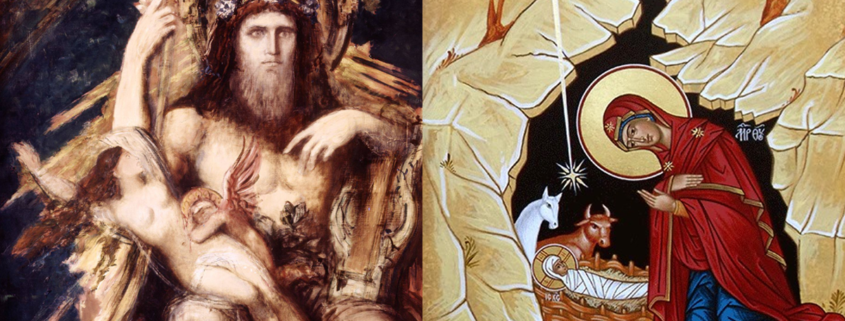The Birth of Mercy
Recently, a psychology professor by the name of Erik Sprankle stated that the Virgin Mary may not have given ‘consent’ when the angel Gabriel told her that she would give birth to Jesus. Besides showing the utter ignorance that is overwhelming in academia, the professor proved how much contemporary thought is possessed by ideological and identitarian groupthink.
In reality, it is hard for ideologues to shape a crucifixion-haunted world into their own image, for Christ had already shattered the very foundation of ideology: violent force. The virgin birth story speaks of something remarkable and unprecedented in human history. It gives us a completely new perspective on the role of human beings voluntarily creating an underground society that would ultimately reshape the world in the image of Jesus Christ.
In the times before Christ and outside the Hebrew people, the world had been largely dominated by grand narratives that empowered lynch mobs and thus gave rise to the notion of ‘might is right.’ We know these narratives today as the classical myths of the ancient world. These myths, such as the birth of Dionysus, contain evidence that reveals the empowering of the accusing mob in ancient pagan societies.
In his book, Things Hidden Since the Foundation of the World, René Girard explains the violent origins of the pagan birth myths:
Stories of this kind always involve more than a hint of violence. Zeus bears down on Semele, the mother of Dionysus, like a beast of prey upon its victim, and in effect strikes her with lightning. The birth of the gods is always a kind of rape…These monstrous couplings between men, gods and beasts are in close correspondence with the phenomenon of reciprocal violence and its method of working itself out. The orgasm that appeases the god is a metaphor for collective violence.
It is almost as if the virgin birth account of the New Testament were written as a response to the birth myths of the Greek gods. In the gospels, Mary’s status, unlike that of Semele’s, is elevated by God to that of nobility. In the gospel of Luke, the angel Gabriel greets Mary by saying, “Hail, O favored one, the Lord is with you!” God makes known to Mary that she will bring forth his son, to which Mary replies, “Behold I am the handmaid of the Lord; let it be to me according to your word.” There is a complete absence of violence and coercion in the virgin birth story. There is no element of force whatsoever.
For centuries, humanity has operated under a principle of ritual sacrifice, where the sacrifice of one may bring the temporal unity of many. Our modern-day society, despite the lack of extravagant mythologies, still operates under this same principle. We divide ourselves into factions and are forever in search for that one sacrifice, that one execution which will bring us nearer to utopia. Mass incarceration of innocents to rid ourselves of crime, abortion to bring family stability, and war to bring peace. This is the story of the rape of Semele, of achieving good through coercion. The mortal and vulnerable becomes nothing more than a means to an end. It is not so with the God of the Bible.
When Christ was born, singing could be heard coming down from heaven. “Glory to God in the highest,” the angels sang, “And on earth peace, goodwill toward men!” The image of a lowly teenage girl giving birth to the Son of God, among animals and poor shepherds in a manger, turns the powers and principalities of the world on their heads. This was God and the human race working together to create a kingdom of peace on earth, one that the prophet Daniel predicted will outlast the empires of men.
The God of the Bible brings order and peace through mercy and self-sacrifice. The mortal and the vulnerable is proclaimed to be the image bearer of God, and Mary is given the honor to become the mother of divinity. The young Mary accepts this honor, and in doing so she becomes a precursor to her own son dying on the cross. This divine dance of self-sacrifice would come full circle when Mary, an old woman by now, would stand at the feet of the cross upon which her son would die for the sins of the world.
With Christ’s birth, Mary is bestowed with the privilege of becoming the mother of the divine emperor Jesus. She represents mankind voluntarily partaking with God in bringing the kingdom of God to a world riddled with violence and degeneracy. The birth of a child signifies how Jesus’ kingdom would undermine the mob-rule and totalitarian nature of power in our age. The way of God is of self-sacrifice–the willingness to be expelled from the confines of worldly power–in such a way as to deconstruct and lay bare the evil of worldly power to all of humanity, thus enabling us to forsake violence and embrace mercy.
Mercy can only come about when we see others as children of God, and when we think of children we see the infant Jesus, innocence and vulnerability personified, lying in the bosom of a human mother. Nothing is as dangerous to a sacrificial machinery as a small child and his mother carrying within them an overwhelming value—the spark of divinity. The birth of Christ, like the crucifixion, calls on us to treat our neighbor as we would the child Christ and his mother Mary; it calls us to imitate these two brilliant self-sacrificing personalities, and through imitation, it calls us to compassion. The way of Zeus raping Semele is dead, and nothing, not even our ideological saber-toothed concern for victims, can ever replace it, except for self-sacrifice, voluntary negotiation, and mercy.
This article originally appeared on LibertarianChristians.com










Leave a Reply
Want to join the discussion?Feel free to contribute!